
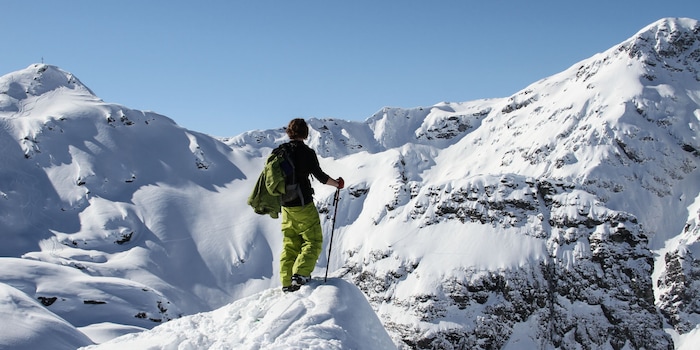
9 tips for safe and enjoyable winter hiking
Want to get up high and storm the mountain peaks in winter too? With these nine tips from outdoor blogger Martin Stiegler, you can do so with reduced risk and maximum comfort.
1. dress in the onion skin system
We've probably all heard it from our mum: "Dress warmly". The onion system is the best way to do this. This is particularly important when hiking in cold weather, as temperatures can vary greatly. Early in the morning without sunshine it is still freezing cold, later with movement and sunshine it gets warmer. You can regulate and constantly adjust your insulation with different layers of clothing. I like to wear long underwear as the first layer, then a light fleece or softshell jacket and waterproof trousers. I then add an insulated jacket (either down or synthetic fibre) and/or a waterproof shell jacket (in bad weather). You can find out more about this topic in my article "Dressing properly in winter".
.
2. start early in the day
Consider the distance and difficulty of the trail when planning your first winter hike. While it's child's play to do a 15-kilometre circular hike in summer, it can be much more strenuous in winter with ice or deep snow on the same path. What's more, many access roads are closed in winter, which makes the journey considerably longer. There are few things more frustrating than wading through metres and metres of waist-deep snow. So it's best to choose a route that you know you can manage without difficulty. Winter hiking trails in ski resorts are a good place to start, as they are usually well prepared with snow groomers. What's more, you'll have no problem finding your way back on the well-signposted paths, even in fog and snow. Don't forget that the sun sets earlier in the winter months. Therefore, start early in the day and be back in good time before nightfall.
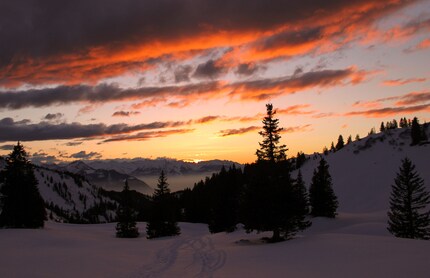
3. Take safety equipment with you
There are a few basic items that every winter hiker should carry with them in case of an emergency. Apart from the standard hiking equipment, you should always carry a map, a first aid kit and a headlamp. For longer and more difficult tours, a bivouac sack is also a good idea in case you get into an emergency situation. [[productlist:6003031,5636775,6727924]]
4. check the weather forecast
Although this may seem like an obvious tip, people often neglect to take a close look at the weather forecast. Take a look at the forecast precipitation over the course of the day, the wind speeds and the hours of sunshine. The avalanche report is also important information, especially for winter hikes above the tree line. If you are inexperienced, approach longer winter hikes slowly. In fog and snowfall, it's easier to lose your bearings than you think.
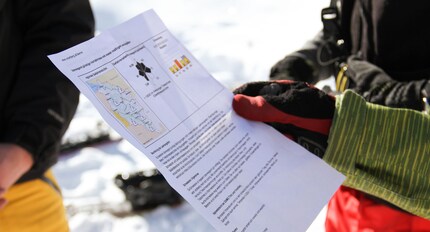
5. learn how to use a grödel, crampons and snowshoes
When the trail is icy, crampons can make the difference between summit happiness and turning back. If you have no experience with crampons, ask a mountain guide or an experienced friend to show you the right technique. For winter hikers who don't want to go too high, grödel are sufficient. These can be fitted to all types of boots and provide a firm grip on icy surfaces. Snowshoes are suitable for excursions in deeper snow.
6. Take an experienced friend with you
Hiking with friends is always the way to go, especially in winter. Not only is it more fun to share the adventure with others, it's also safer to be travelling in a group. An experienced friend can help you choose your equipment and show you how to use crampons or snowshoes. If you can't find an experienced winter hiker in your circle of friends, hire a mountain guide or join an SAC group.
If you go out alone, let someone at home know where you are going and when you will be back. This way, someone can contact the rescue service if something should happen to you.
7. warm yourself up with hot drinks
It is also important to drink plenty of fluids when hiking in winter. A hot drink warms you up from the inside and provides additional motivation. Depending on your taste, you can put tea, coffee or cocoa in your thermos flask. There's nothing better than a short break with a warm drink of your choice to motivate you for the summit attempt. [[productlist:6071980]]
8. Be ready to turn around
As the extreme mountaineer Hans Kammerlander correctly stated: "A summit only belongs to you when you're back down - because before that, it belongs to you." Take this to heart and don't hesitate to turn back if you're overwhelmed or running out of time. The summit of a mountain is only half the journey! You must always have enough time and energy left for the way back. It helps to plan the tour well and to be aware of any difficult sections early on. Planning also helps you to estimate whether you are on time.
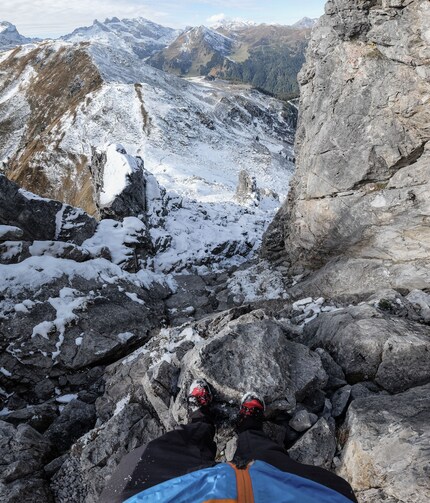
9. Treat yourself to a good meal as a reward
Last but not least: Reward yourself for the successful hike. Hopefully you've burnt enough calories to treat yourself to a delicious comfort meal. Whether it's a thickly topped burger, a crispy pizza or a Kaiserschmarren at the hut: The main thing is that it tastes good and motivates you for the next time.
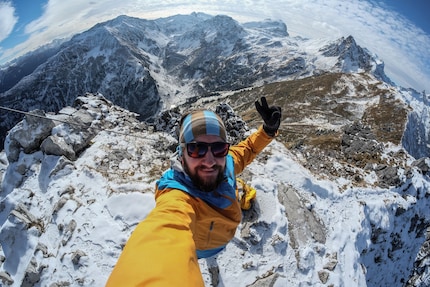
Already as a child I spent every free day in nature and roamed through the woods. In the meantime I have grown up, but the love for nature has remained. On my blog OUTCOZO I write about everything that has to do with outdoors and I want to share my adventures with the readers. From glacier tours to freeride descents, from mountain bivouacs to equipment testing, everything is included. The main thing is "Outside the couch zone". <br><br>
More of me under:
<a href="http://www.outcozo.com/" target="_blank">outcozo.com</a>
From the latest iPhone to the return of 80s fashion. The editorial team will help you make sense of it all.
Show all